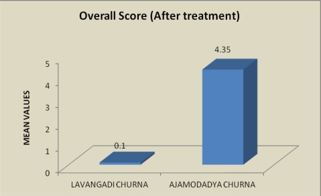A randomised comparative clinical study to assess the efficacy of Lavangadi Churna over Ajamodadya Churna in the management of Amavata
DOI:
https://doi.org/10.21760/jaims.7.10.10Keywords:
Amavata, Ajamodadya Churna, Lavangadi Churna, Rheumatoid Arthritis, Stiffness.Abstract
Background - Amavata is a disease, where involvement of Ama and Vata can be seen. Here formation of Ama and vitiation of Vata take place simultaneously by their respective causative factors. Acharya Madhavakara has described the Amavata first. This Amavata can be compared with Rheumatoid arthritis showing similarities in clinical features. Objective - To assess the effect of Lavangadi churna over Ajamodadya Churna in the management of Amavata. Materials and Methods - The sample size of the study consists of 40 patients of Amavata. and either sex of age group 20-60years. Patients were randomly selected and grouped into 2 groups namely Group A & Group B. Group A were given Lavangadi churna and Group B were given Ajamodadya Churna. The dosage of both the drug is 3gms twice in a day after food with lukewarm water. Follow up was fixed every 15th day i.e., 1st follow up on 15th day, 2nd follow up on 30th day, after treatment follow up on 45th day and duration of treatment was fixed 1 month. Patients were advised to follow Pathyapathya throughout the study. A special proforma was made to record the observation based on subjective and objective parameters. Results and Conclusion - Overall effect of the trial drug showed good response in both subjective parameters & objective parameters and Overall effect of the control drug showed good response in some parameters like Heaviness, Anorexia, Thirst, Fever. Hence trial dug supported research hypothesis. Intervention was cost effective, adaptable, and safe.
Downloads
References
Shri Madhavakara, Madhava Nidanam with Madhu kosha commentary, by Dr. P. Himasagara Chandra Murthy, Chowkambha Sanskrit Series office Varanasi 3rd edition, 2013; chapter no.25, shloka no 5.
Yashpal Munjal et al, API text book of medicine, vol. 10th edition Mumbai, association of physicians of India 2015, page no 2492.
Cristopher et al, Davidson’s Principles and practice of medicine, ed. 17th, pub- Churchill Livingstone, Pearson professional limited New York, page no. 1101.
Kasper Dennis et.al, Harrison’s Principles of internal medicine vol Ⅱ 19th ed. New York: McGraw Hill publications; 2015. P.2139.
Shri Govinda Dasji, Bhaishajya Ratnavali, edited by Shri Brahmashankara Mishra, English translation by Dr. Kanjiv Lochan Vol 2, Chaukambha Sanskrit Bhavan 2006, chapter no 32, shloka no 56-59.
Sharangadhara, Sharangadhara Samhita, with Sanskrit commentary Dipika, by Prof. Dr. Shriram S Savrikar, chowkambha Sanskrit Pratishthan, 1st edition 2019, chapter no 6, shloka no 113-117.
Maharshi Agnivesa, Acharya Charaka, Drudabala, Charaka Samhita chikitsa sthana, with Ayurveda Dipika commentary, by Laxmidhar Dwivedi, editor & commentator Dr. B.K Dwivedi, Chowkhamba Krishnadas Academy Varanasi 2013 chapter no 28, shloka no 59.
Maharshi Agnivesa, Acharya Charaka, Drudabala, Charaka Samhita chikitsa sthana, with Ayurveda Dipika commentary, by Laxmidhar Dwivedi, editor & commentator Dr. B.K Dwivedi, Chowkhamba Krishnadas Academy Varanasi 2013 chapter no 22, shloka no 15.
Maharshi Agnivesa, Acharya Charaka, Drudabala, Charaka Samhita chikitsa sthana, with Ayurveda Dipika commentary, by Laxmidhar Dwivedi, editor & commentator Dr. B.K Dwivedi, Chowkhamba Krishnadas Academy Varanasi 2013 chapter no 12, shloka no 8.















